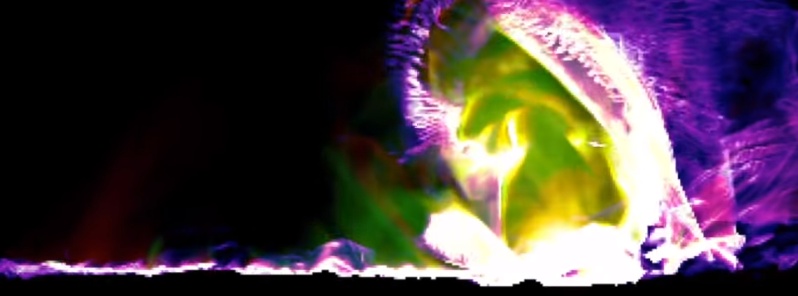Comprehensive simulation of a solar flare

A team of scientists has, for the first time, used a single, cohesive computer model to simulate the entire life cycle of a solar flare: from the buildup of energy thousands of kilometers below the solar surface, to the emergence of tangled magnetic field lines, to the explosive release of energy in a brilliant flash.
The accomplishment, detailed in the journal Nature Astronomy, sets the stage for future solar models to realistically simulate the Sun's own weather as it unfolds in real time, including the appearance of roiling sunspots, which sometimes produce flares and coronal mass ejections.

For the new study, the scientists had to build a solar model that could stretch across multiple regions of the Sun, capturing the complex and unique physical behavior of each one.
The resulting model begins in the upper part of the convection zone — about 10 000 km (6 200 miles) below the Sun's surface — rises through the solar surface, and pushes out 40 000 km (25 000 miles) into the solar atmosphere, known as the corona. The differences in gas density, pressure, and other characteristics of the Sun represented across the model are vast.
"This was a stand-alone simulation that was inspired by observed data," said NCAR scientist Matthias Rempel. "The next step is to directly input observed data into the model and let it drive what's happening. It's an important way to validate the model, and the model can also help us better understand what it is we're observing on the Sun."
Featured image: The violet color represents plasma with temperature less than 1 million Kelvin. Red represents temperatures between 1 million and 10 million Kelvin, and green represents temperatures above 10 million Kelvin. Credit: Mark Cheung, Lockheed Martin, and Matthias Rempel, NCAR

MAGNETIC FIELDS ARE CONTINUOUS THROUGHOUT THE UNIVERSE, SINCE THEY ARE PERMANENTLY PRESENT IN THE BUILDING BLOCKS OF MATTER. IN FACT, IF MAGNETIC FIELDS ARE NOT CONTINUOUS THE UNIVERSE WOULD COLLAPSE ON ITSELF INSTANTLY. THE DISTRIBUATION OF MATTER IN THE COSMOS FROM THE SMALLEST SCALE STRUCTURE TO THE LARGEST ONE IS ABSOLUTELY RULED BY THE CONTINUOUS MAGNETIC FIELDS THAT ARE LINKED TO EACH OTHER IN AN INFINITE ORDER.
Theoretical physicists can come up with as many magnetic reconnection based-models as they want, but that does not eliminate the fact, that the concept of magnetic reconnection is physically groundless. Magnetic field lines are not physical entities. They are only mathematical visualization or aid. So, how can magnetic field lines reconnect if they do not exist at all? As, Nicholas Sykes from the electric Universe, accurately stated Lines of magnetic force are not a physical entities, any more than are the contours of a geographer’s map, or the isobars of a weatherman’s chart. One might just as well talk about a “contour reconnection” as being the explanation of a volcanic eruption, as to consider “magnetic reconnection” to be an explanation of energy outbursts of various sorts.” Read the rest on page 10 of my research paper, THE EXTERNAL ENERGY SUPPLY TO THE SUN IS OVERWHELMINGLY OBVIOUS AND HAS RECENTLY BEEN DETECTED BY SPACE PROBES at the following link http://www.journalcra.com/sites/default/files/issue-pdf/23817.pdf